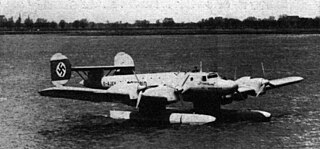Gulfstream Aerospace Corporation is an American aircraft company and a wholly owned subsidiary of General Dynamics. Gulfstream designs, develops, manufactures, markets, and services business jet aircraft. Gulfstream has produced more than 2,000 aircraft since 1958. Gulfstream's current range consists of the G280, G550, G500/G600, and G650/G650ER/G700/G800.

The Blohm & Voss Ha 139 was a German all-metal inverted gull wing floatplane. With its four engines it was at the time one of the largest float-equipped seaplanes that had been built. The inboard engines were mounted at the joint between the inboard anhedral and outboard dihedral wing sections, above the pylon-mounted floats.

The Rutan Model 40 Defiant is a four-seat, twin-engine homebuilt aircraft with the engines in a push-pull configuration. It was designed by aerospace engineer Burt Rutan for the Rutan Aircraft Factory.

The IAI Westwind is a business jet initially produced by Aero Commander as the 1121 Jet Commander. Powered by twin GE CJ610 turbojets, it first flew on January 27, 1963, and received its type certification on November 4, 1964, before the first delivery. The program was bought by Israel Aircraft Industries (IAI) in 1968, which stretched it slightly into the 1123 Westwind, and then re-engined it with Garrett TFE731 turbofans into the 1124 Westwind. The 16,800–23,500 lb (7.6–10.7 t) MTOW aircraft can carry up to 8 or 10 passengers, and 442 were produced until 1987.

The LearAvia Lear Fan 2100 was a turboprop business aircraft designed in the 1970s, with an unusual configuration. The Lear Fan never entered production.

The Gulfstream American GA-7 Cougar is an American all-metal, 4-seat, twin-engined light aircraft. The Cougar was a twin-engine development of the Gulfstream American AA-5B Tiger and traces its lineage to the AA-1 Yankee Clipper and the Bede BD-1.

The Temco TT Pinto is a tandem two-seat primary jet trainer built for the United States Navy by Temco Aircraft of Dallas, Texas.

The Grumman Gulfstream I is a twin-turboprop business aircraft. It first flew on August 14, 1958.

The Gulfstream G100, formerly known as the IAI Astra SPX, is an Israel Aerospace Industries-manufactured twin-engine business jet, that was produced for Gulfstream Aerospace. Deliveries began in 1986. The United States Navy employs the aircraft as the C-38A Courier. A later derivative known as the G150 was launched in 2002. Gulfstream announced the final sale of the G150 in September 2016 and the last delivery by mid-2017.

The RFB Fantrainer is a two-seat flight training aircraft which uses a mid-mounted ducted fan propulsion system. Developed and manufactured by German aircraft company Rhein-Flugzeugbau GmbH (RFB), it has been used by the Luftwaffe and Royal Thai Air Force.

The SyberJet SJ30 is a light business jet built by American company SyberJet Aircraft. In October 1986, Ed Swearingen announced the new design, a 6 to 8 person aircraft powered by two Williams FJ44 turbofans. Initially backed by Gulfstream Aerospace from October 1988, the Jaffe Group took over in September 1989 and the first SJ-30 flew on February 13, 1991 but development halted afterwards. The Taiwan-based Sino Swearingen Aircraft Corporation rescued the program, the jet was stretched by 4.3 ft into the SJ30-2 with a wingspan increased by six feet.

The Gulfstream G200, formerly known as the IAI Galaxy, is a twin-engine business jet. It was designed originally by Israel Aerospace Industries (IAI) and was produced by IAI for Gulfstream Aerospace from 1999 through 2011.

The PZL P.1 was a Polish fighter, designed by the engineer Zygmunt Puławski, manufactured by the PZL state-owned factory. It remained a prototype, but it was the first of the Polish PZL gull wing fighter series, leading to the PZL P.7, PZL P.11 and PZL P.24.

The Gulfstream American Hustler was a 1970s American mixed-power executive/utility aircraft designed by American Jet Industries, which later changed to Gulfstream American Corporation. The aircraft had a nose-mounted turboprop and a tail-mounted turbofan.

The Foxjet ST600 was a small business jet under development in the United States in the late 1970s. Problems with development, particularly in finding a suitable powerplant, caused the project to be abandoned before any substantial work on the prototype had been done, but the concept proved to be ahead of its time, foreshadowing the very light jets of thirty years later.

The Gulfstream American Peregrine 600 was a military trainer aircraft developed in the United States in the early 1980s but which did not progress further than prototype stage. Developed from the company's Hustler business aircraft, the Peregrine shared the same wings, empennage and rear fuselage, but had a new forward fuselage with side-by-side seating for the pilot and instructor. The aircraft was developed as a contender in the United States Air Force's Next Generation Trainer program, but was ultimately passed over in favor of the Fairchild T-46. Attempts to market it to the air forces of Australia, New Zealand, Japan, and China also proved unsuccessful, and the project was canceled in 1985. The wing and rear fuselage design was incorporated in the Gulfstream Aerospace Peregrine business aircraft.

The Gulfstream G400, G500, and G600 (GVII) are twin-engine business jets designed and produced by Gulfstream Aerospace. The aircraft are designated Gulfstream GVII-G500 and GVII-G600 in their type certificate.
The SZD-25A Lis was a single-seat glider aircraft that was designed and built in Poland from 1955, derived from the SZD-16 Gil and SZD-25 Nov.

The Gulfstream G280 is a twin-engine business jet built by Israel Aerospace Industries (IAI) for Gulfstream Aerospace. It began delivery to users in 2012.

The Spike S-512 is a projected supersonic business jet, designed by Spike Aerospace, an American aerospace manufacturer firm based in Boston, Massachusetts.


















